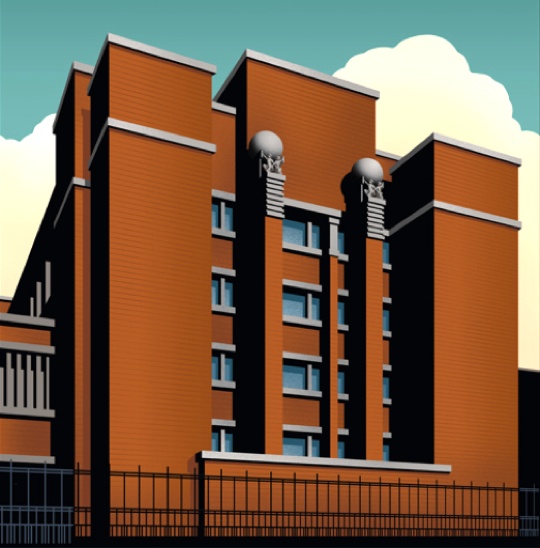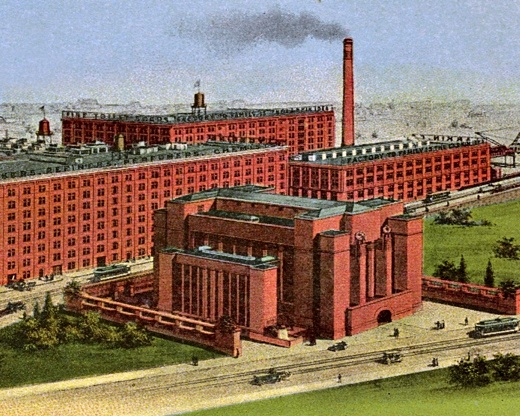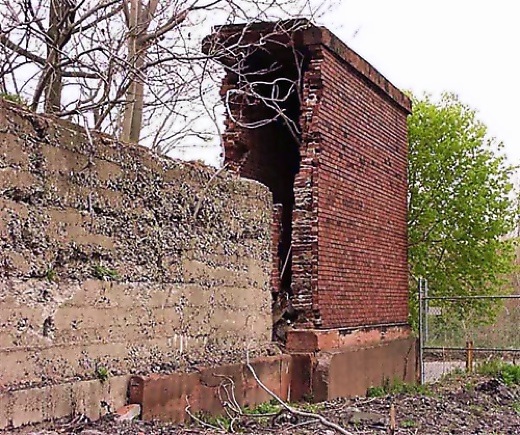SUBHEAD: Could those who built the Larkin Building have imagined that their city would be a ruins in a century.
By James Kunstler on 9 June 2014 for Kunstler.com -
(http://kunstler.com/clusterfuck-nation/that-was-then-this-is-now/)

Image above: Detail of poster of the Larkin Building, in Buffalo, New York, designed by Frank Lloyd Wright in 1904. From (http://inkwellstudiosblog.blogspot.com/2013/08/the-larkin-building.html).
I was in Buffalo, New York, over the weekend at the annual conclave of New Urbanists — a movement started in the 1990s to rescue American towns and cities. The scale of desolation of that city is not as spectacular or vast as Detroit’s, but the visible symptoms of the illness are the same.
One of the events was a bicycle tour of Buffalo’s neglected East Side, where maybe 80 percent of the houses are gone and the few that remain stand amid spring wildflower meadows and the human density per acre appears too low even for successful drug-selling.
The old economy is gone and is replaced now by a “social services economy,” meaning government checks, SNAP cards, and purposelessness. There were zero signs of commerce there block after block, not even a place to buy potato chips. So, as it works out, the few remaining denizens of this place must spend half their waking hours journeying to a food store.
How they make that journey is hard to tell. There were almost no cars anywhere nor buses to be seen. Before long surely the people will all be gone, too, ending a chapter in American urban history.
At one edge of the East Side neighborhood stood the hulking, gigantic remnants of the Larkin soap company, a haunted brick behemoth plangent with silence, ailanthus trees sprouting from the parapets and birds nesting in the gigantic, rusted ventilation fans.

Image above: Rendering of the administration building and factory of the Larkin Soap Company in Buffalo, New York in 1906. Click to embiggen. From (http://misterdangerous.files.wordpress.com/2013/01/larkin.jpg).
The administration building of this deeply paternalistic company was famously designed by Frank Lloyd Wright, completed in 1906, and demolished in 1950 — a blink of an eye. It is considered the architect’s lost masterpiece. The site became a parking lot and now is just an empty asphalt pad with mulleins and sumacs spiking up in the pavement.
At its height of success a hundred years ago, the Larkin Company provided a stupendous bounty of social support services for its 4,500 employees: a dental office at nominal prices, dedicated rooms at local hospitals, an on-premises branch of the city library, subsidized night school classes, gyms, lounges, sports clubs, a credit union, insurance plans, and more.
The people could ride streetcars all over the “Electric City,” as Buffalo styled itself because of its fortunate proximity to the bonanza of hydro power from Niagara Falls.
A hundred years ago, Buffalo was widely regarded as the city of the future. The boon of electrification made it the Silicon Valley of its day. It was among the top ten US cities in population and wealth. It’s steel industry was second to Pittsburgh and for a while it was second to Detroit in cars.
Now, nobody seems to know what Buffalo might become, if anything. It will be especially interesting when the suburban matrix around it enters its own inevitable cycle of abandonment. I’m convinced that the Great Lakes region will be at the center of an internally-focused North American economy when the hallucination of oil-powered globalism dissolves.
Places like Buffalo, Cleveland, and Detroit will have a new life, but not at the scale of the twentieth century. On this bike tour the other day, I rode awhile beside a woman who spends all her spare time photographing industrial ruins. She was serenely adamant that the world will never see anything like that era and its artifacts again. I tend to agree.
We cannot grok the stupendous specialness of the past century, and certainly not the fact that it is bygone for good. When people use the term “post-industrial” these days, they don’t really mean it, and, more mysteriously, they don’t know that they don’t mean it. They expect complex, organized, high-powered industry to still be here, only in a new form.
They almost always seem to imply (or so I infer) that we can remain “modern” by moving beyond the old smoke and clanking machinery into a nirvana of computer-printed reality. I doubt that we can maintain the complex supply chains of our dwindling material resources and run all those computer operations — even if we can still manage to get some electricity from Niagara Falls.
In my forthcoming novel A History of the Future (third installment of the World Made By Hand series), two of my characters journey to Buffalo a couple of decades from now. They find a town with its back turned to abandoned monuments of the industrial age. All the action is on the Lake Erie waterfront where trade is conducted by sailing ships at the scale of Sixteenth century, but with an identifiable American gloss.
I’d be surprised if one in a thousand educated people in this country (including the New Urbanists) can take that vision seriously. But do you suppose that the executives of an enterprise like the Larkin Company would have ever imagined the desolation of Buffalo a mere century later?

Image above: The ruins of the enclosing wall of the Larkin Administration Building faces an empty lot. From (http://www.prairieschooltraveler.com/rip/rip.html).
.
By James Kunstler on 9 June 2014 for Kunstler.com -
(http://kunstler.com/clusterfuck-nation/that-was-then-this-is-now/)

Image above: Detail of poster of the Larkin Building, in Buffalo, New York, designed by Frank Lloyd Wright in 1904. From (http://inkwellstudiosblog.blogspot.com/2013/08/the-larkin-building.html).
I was in Buffalo, New York, over the weekend at the annual conclave of New Urbanists — a movement started in the 1990s to rescue American towns and cities. The scale of desolation of that city is not as spectacular or vast as Detroit’s, but the visible symptoms of the illness are the same.
One of the events was a bicycle tour of Buffalo’s neglected East Side, where maybe 80 percent of the houses are gone and the few that remain stand amid spring wildflower meadows and the human density per acre appears too low even for successful drug-selling.
The old economy is gone and is replaced now by a “social services economy,” meaning government checks, SNAP cards, and purposelessness. There were zero signs of commerce there block after block, not even a place to buy potato chips. So, as it works out, the few remaining denizens of this place must spend half their waking hours journeying to a food store.
How they make that journey is hard to tell. There were almost no cars anywhere nor buses to be seen. Before long surely the people will all be gone, too, ending a chapter in American urban history.
At one edge of the East Side neighborhood stood the hulking, gigantic remnants of the Larkin soap company, a haunted brick behemoth plangent with silence, ailanthus trees sprouting from the parapets and birds nesting in the gigantic, rusted ventilation fans.

Image above: Rendering of the administration building and factory of the Larkin Soap Company in Buffalo, New York in 1906. Click to embiggen. From (http://misterdangerous.files.wordpress.com/2013/01/larkin.jpg).
The administration building of this deeply paternalistic company was famously designed by Frank Lloyd Wright, completed in 1906, and demolished in 1950 — a blink of an eye. It is considered the architect’s lost masterpiece. The site became a parking lot and now is just an empty asphalt pad with mulleins and sumacs spiking up in the pavement.
At its height of success a hundred years ago, the Larkin Company provided a stupendous bounty of social support services for its 4,500 employees: a dental office at nominal prices, dedicated rooms at local hospitals, an on-premises branch of the city library, subsidized night school classes, gyms, lounges, sports clubs, a credit union, insurance plans, and more.
The people could ride streetcars all over the “Electric City,” as Buffalo styled itself because of its fortunate proximity to the bonanza of hydro power from Niagara Falls.
A hundred years ago, Buffalo was widely regarded as the city of the future. The boon of electrification made it the Silicon Valley of its day. It was among the top ten US cities in population and wealth. It’s steel industry was second to Pittsburgh and for a while it was second to Detroit in cars.
Now, nobody seems to know what Buffalo might become, if anything. It will be especially interesting when the suburban matrix around it enters its own inevitable cycle of abandonment. I’m convinced that the Great Lakes region will be at the center of an internally-focused North American economy when the hallucination of oil-powered globalism dissolves.
Places like Buffalo, Cleveland, and Detroit will have a new life, but not at the scale of the twentieth century. On this bike tour the other day, I rode awhile beside a woman who spends all her spare time photographing industrial ruins. She was serenely adamant that the world will never see anything like that era and its artifacts again. I tend to agree.
We cannot grok the stupendous specialness of the past century, and certainly not the fact that it is bygone for good. When people use the term “post-industrial” these days, they don’t really mean it, and, more mysteriously, they don’t know that they don’t mean it. They expect complex, organized, high-powered industry to still be here, only in a new form.
They almost always seem to imply (or so I infer) that we can remain “modern” by moving beyond the old smoke and clanking machinery into a nirvana of computer-printed reality. I doubt that we can maintain the complex supply chains of our dwindling material resources and run all those computer operations — even if we can still manage to get some electricity from Niagara Falls.
In my forthcoming novel A History of the Future (third installment of the World Made By Hand series), two of my characters journey to Buffalo a couple of decades from now. They find a town with its back turned to abandoned monuments of the industrial age. All the action is on the Lake Erie waterfront where trade is conducted by sailing ships at the scale of Sixteenth century, but with an identifiable American gloss.
I’d be surprised if one in a thousand educated people in this country (including the New Urbanists) can take that vision seriously. But do you suppose that the executives of an enterprise like the Larkin Company would have ever imagined the desolation of Buffalo a mere century later?

Image above: The ruins of the enclosing wall of the Larkin Administration Building faces an empty lot. From (http://www.prairieschooltraveler.com/rip/rip.html).
.
No comments :
Post a Comment